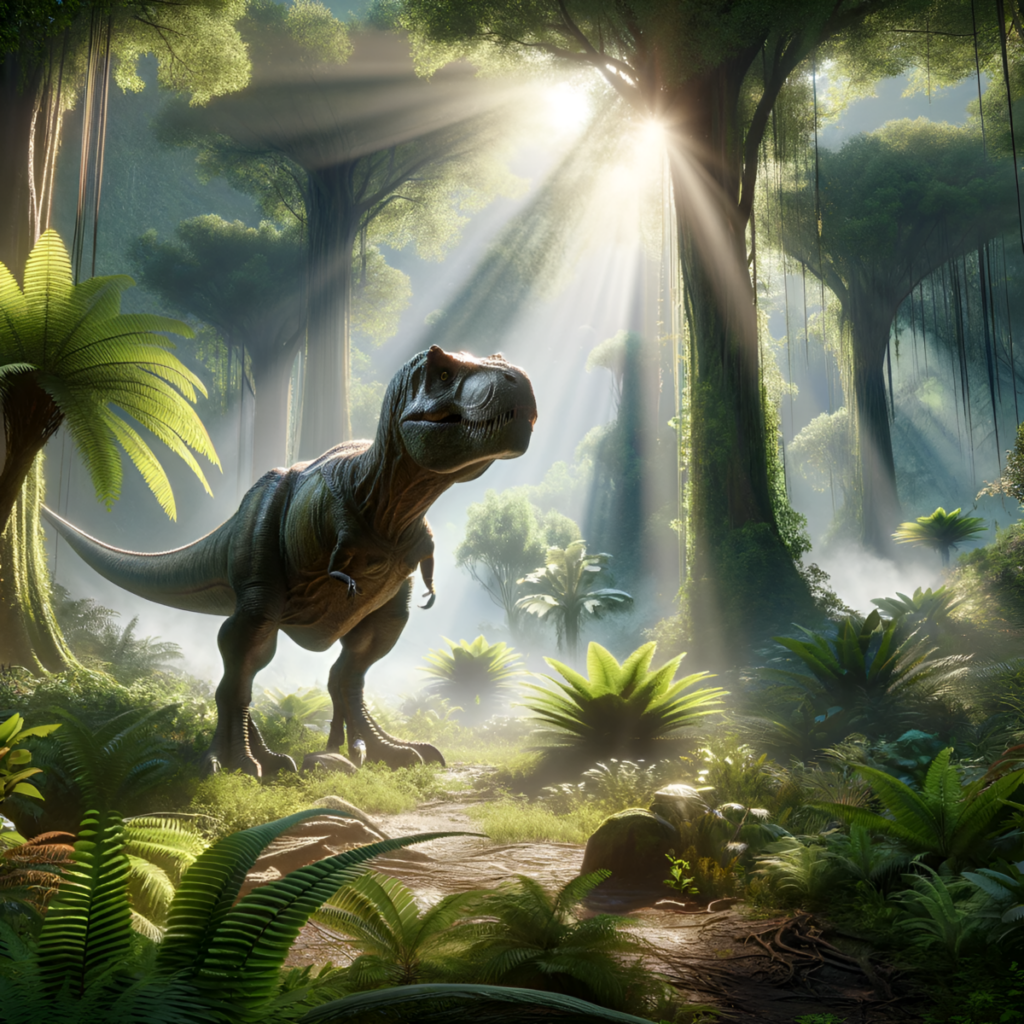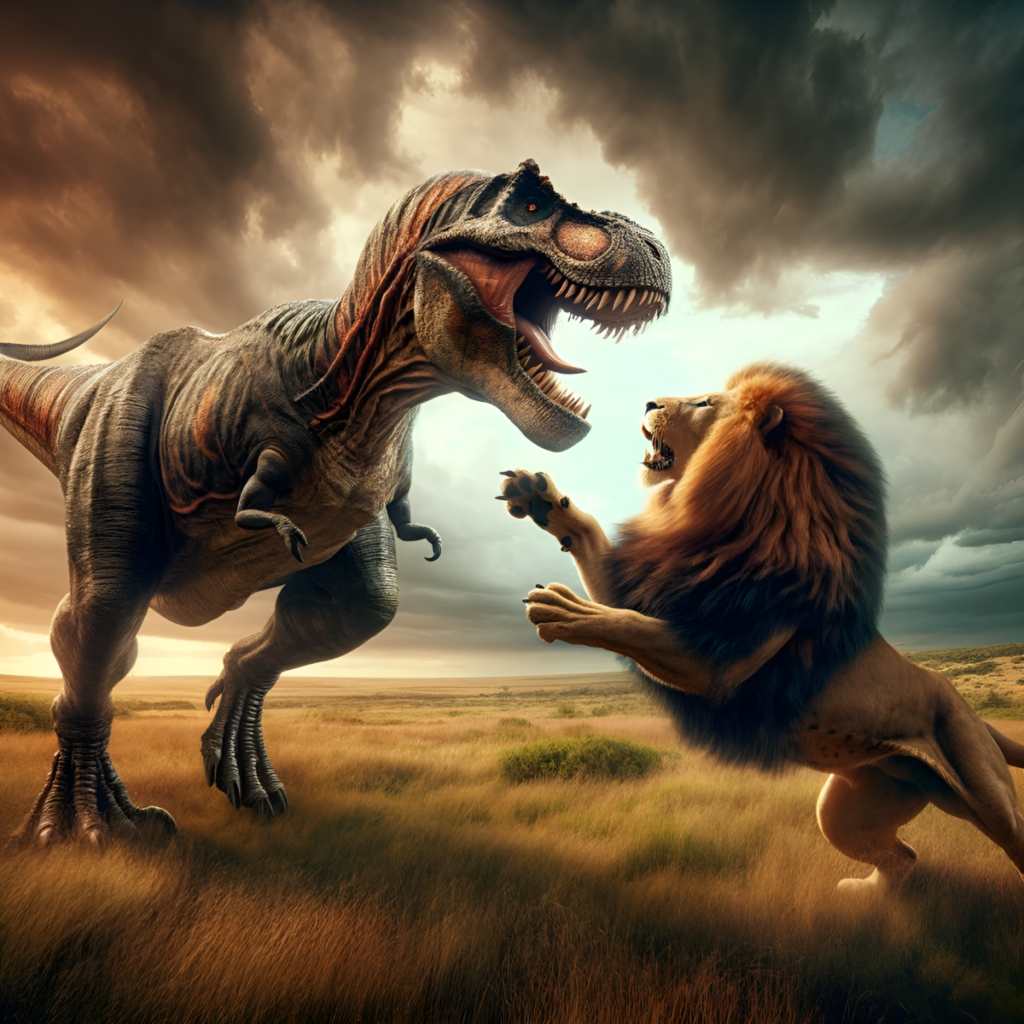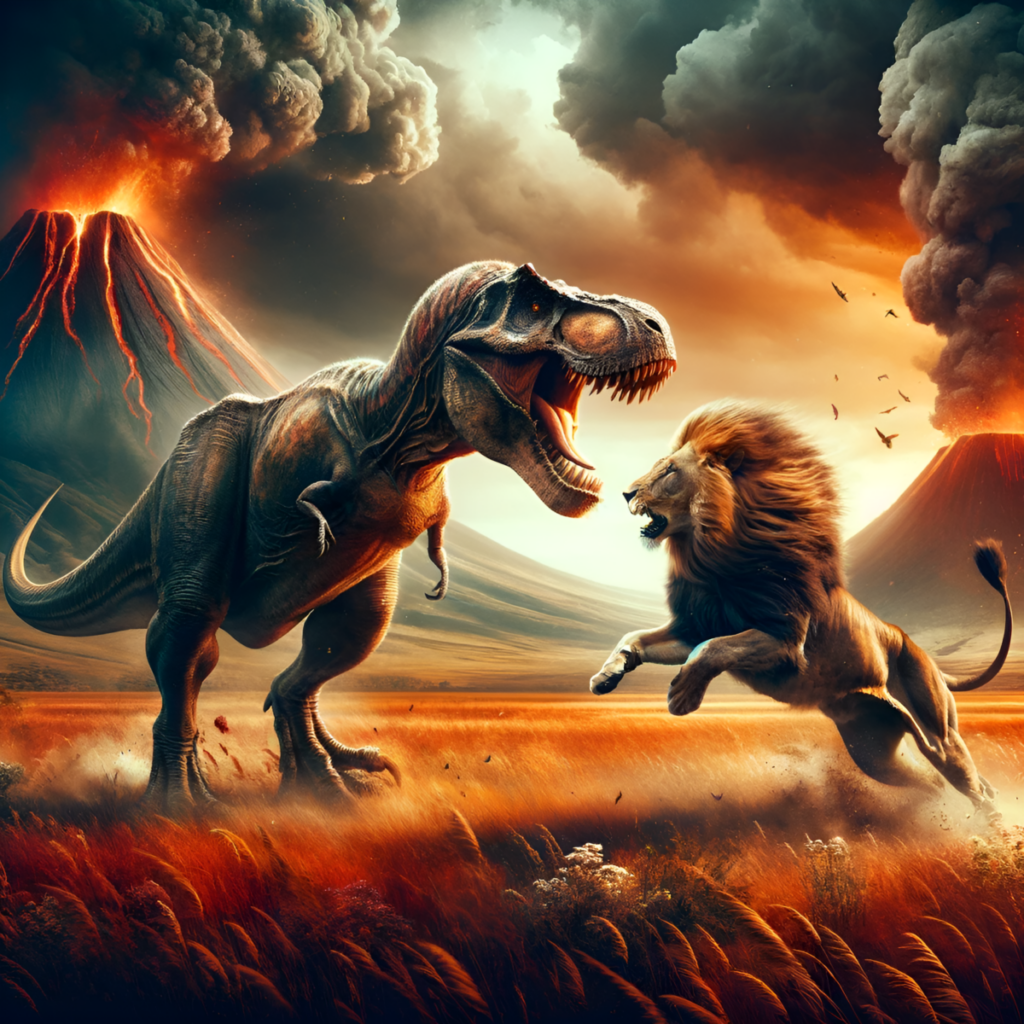The fascinating world of prehistoric creatures and modern predators has sparked many debates about hypothetical encounters between beasts from different eras. One such intriguing debate is who would win in a face-off between the king of the jungle, the fearsome lion, and the notorious, extinct Tyrannosaurus rex. In this article, we will explore the key factors that could contribute to the outcome of this epic battle, looking into their respective physical characteristics, diet and hunting strategies, defense mechanisms, as well as intelligence and social behavior.
While lions and T. rex have never coexisted in history, it’s fun to imagine what would transpire if they were to ever cross paths. T. rex is undoubtedly a captivating specimen from the past, towering over the lion with its immense size and power. On the other hand, lions are known for their agility, social structure, and strategic hunting in groups. However, the question remains, would brute strength prevail over intelligence and social behavior in such a duel?
By assessing the key factors that shape each animal’s survival skills, we hope to shed some light on this hypothetical face-off. Even though it’s impossible to determine an accurate outcome, exploring their unique characteristics and comparing their abilities will provide a better understanding of just how extraordinary both these predators truly are.
Key Takeaways
- Comparing physical characteristics reveals size and power advantage in T. rex, while lions exhibit agility and social hunting skills.
- Examining diet and hunting strategies provides insight into the predators’ preferred prey and tactics.
- Evaluating defense mechanisms and intelligence highlights differences in their approach to survival and potential advantages in a confrontation.
Table of Contents
Comparison
When comparing a lion and a Tyrannosaurus rex, there are several factors to consider. Both animals were apex predators in their respective ecosystems. The lion, predominantly found in Africa, is known for its powerful build, sharp claws, and strong bite. The T-Rex, a dinosaur that lived around 68-66 million years ago in North America, was one of the largest meat-eating dinosaurs with an incredibly powerful jaw and fearsome teeth.

In terms of physical attributes, the T-Rex far surpasses the lion in both size and weight. The average adult T-Rex could reach a height of up to 17 feet, while lions only stand around 4 feet at the shoulder. Furthermore, a T-Rex could weigh around 9 tons, whereas an adult lion weighs between 330 and 550 pounds. This significant difference in size and weight would undoubtedly give a T-Rex a tremendous advantage in a hypothetical encounter.

However, lions are not solitary creatures. They typically live and hunt in groups known as prides, which allow them to bring down larger prey such as adult elephants or buffalo. A group of lions could potentially use their numbers and coordinated strategy to attempt an attack on a T-Rex. Nonetheless, the sheer size, strength, and ferocity of a T-Rex still pose a near-insurmountable challenge.
Another factor to consider is the ecosystem each animal inhabits. Lions currently face predators and competitors such as leopards, hyenas, and cheetahs in their African habitat. A T-Rex, on the other hand, dealt with other large theropod dinosaurs, including the Spinosaurus and Utahraptor, along with formidable herbivores such as Triceratops and Ankylosaurus.
In a hypothetical fight between a lion and a T-Rex, the extensive physical differences tilt the scales in favor of the T-Rex. While lions are agile and intelligent hunters, the sheer size, strength, and weaponry of a T-Rex would make it an almost impossible foe for a lion to defeat. It’s worth noting, though, that the comparison between these two predators, separated by millions of years, remains a fascinating point of discussion and speculation.
Physical Characteristics
The lion (Panthera leo) and the Tyrannosaurus rex are two of the most well-known and fearsome predators in their respective ecosystems. However, their physical characteristics differ significantly due to their separate evolutionary paths and habitats.
Size and Weight: The T. rex was a massive dinosaur, with an adult reaching up to 40 feet (12 meters) in length, 15-20 feet (4.5-6 meters) in height, and a weight of about 9-14 tons. In contrast, adult lions are much smaller, averaging 8-10 feet (2.4-3 meters) in length, 3.9-4.2 feet (1.2-1.3 meters) in height, and weighing around 260-420 pounds (120-191 kilograms). Despite their differences in size, both animals were capable predators.
Teeth and Claws: T. rex had robust, bone-crushing teeth. Its serrated teeth could reach 12 inches (30 centimeters) long, allowing it to tear through flesh and crush bones. Lions, on the other hand, possess 2.5 inches (7 centimeters) long, conical, and sharp teeth. They are designed for gripping and suffocating prey before employing their powerful claws to tear flesh.
Legs and Locomotion: T. rex had strong hind legs that provided support for its massive body. These hind legs allowed the dinosaur to maintain balance and move at a moderate speed. In contrast, a lion’s legs are designed for speed and agility. They can sprint at speeds of up to 46 mph (74 km/h) for short distances, allowing them to hunt down their prey effectively.
While lions and T. rex shared some predatory characteristics, such as teeth and claws adapted for tearing flesh, they evolved to fulfill distinct roles within their respective ecosystems. The size and weight disparity between the two species would have a significant impact on the outcome of a hypothetical encounter between them, with T. rex’s impressive bulk and strength likely posing a formidable challenge for any lion in a battle.
Diet and Hunting
The diet and hunting habits of the lion and Tyrannosaurus rex showcase their unique abilities as apex predators in their respective ecosystems. As large carnivorous animals, both species rely on hunting strategies and physical features to effectively bring down their prey.
In the case of lions, they are known for their social behaviors and group hunting tactics. Typically, a lion’s pride consists of a few adult males, related females, and cubs. The female lions hunt cooperatively, preying mostly on large ungulates. Their attacks are coordinated, using their superior strength, speed, and intelligence to bring down prey much larger than themselves, such as elephants. Lions serve as apex and keystone predators in Africa, reiterating their successful hunting strategies and prowess in taking down prey.
On the other hand, the prehistoric T. rex, one of the most iconic meat-eating dinosaurs, had a different approach to hunting. While it has been widely debated whether T. rex was primarily a scavenger or a hunter, its formidable jaw structure and teeth suggest that it was capable of a predatory lifestyle. Weighing several times more than an adult lion, the T. rex undoubtedly had the raw power needed to prey on other large dinosaurs like Triceratops and Titanosaurs. T. rex likely relied on ambush tactics to catch its prey, with its massive legs being better suited for short bursts of speed rather than long chases.
It is also worth noting some of the differences in the ecosystems that these apex predators inhabited. While lions typically hunt in open grasslands and savannas where they can use their speed and agility to their advantage, T. rex lived in what is now western North America, a landmass known as Laramidia. This could have implications for their respective diets, with T. rex preying on other large dinosaurs like the Triceratops, and lions hunting a variety of ungulates such as zebras, wildebeest, and antelope. Finally, competition and collaboration with other species might be different, as modern lions often encounter hyenas and other predators, while T. rex would have dealt with other dinosaurs, like the raptors, within its ecosystem.
Defense Mechanisms
Both the lion and the Tyrannosaurus rex possess distinct defense mechanisms that have evolved over time to protect them against threats and help them survive. While the lion is known for its agility, speed, and powerful teeth, the T. rex boasts a massive size, powerful jaw, and fearsome reputation. This section will explore the defense mechanisms of these two formidable creatures.
The lion, as a modern-day predator, relies primarily on its sharp teeth and strong muscular legs for defense. These attributes allow the lion to attack its prey and stand strong in confrontations with other animals. By comparison, the Tyrannosaurus rex has fewer obvious physical defenses but makes up for it with its sheer size and powerful jaw. In a fight, these features would have likely played a crucial role in intimidating and overpowering opponents, even those as formidable as the Triceratops or Ankylosaurus.
The T. rex is also known for its strong sense of smell, which would have been a significant advantage in tracking down prey and detecting potential threats – including the lesser-known raptor. On the other hand, the lion, being a social animal in its natural habitat, utilizes its strength in numbers to confront challenges and protect itself from harm. A group of lions, known as a pride, can efficiently strategize and cooperate to bring down much larger prey, an ability that few prehistoric animals could replicate.

While the T. rex may not possess the same agility as the lion, it is still considered one of the most powerful predators of all time. The Tyrannosaurus rex’s powerful jaw would have been capable of crushing bones and tearing through flesh with ease, making it a formidable contender in any fight. Similarly, the lion’s muscular legs enable it to deliver powerful kicks during attacks, increasing its chances of survival and success in bringing down prey.
It’s important to note that the environments and ecosystems these animals inhabited were vastly different, and their respective defense mechanisms evolved to best suit their surroundings and the threats they faced. While the T. rex and the lion both possess impressive defensive abilities, their true strengths lie in their adaptability, with each thriving in their respective time periods.
Intelligence and Social Behavior
Lions are social animals and are known for their strong pack mentality. They live in groups called prides, which typically consist of related females and their offspring, along with a few males. This social structure provides lions with numerous advantages, including cooperative hunting and group defense against a rival pride or other predators. The lion’s intelligence also contributes to their survival, as they can strategize and communicate with each other during hunts or when defending their territory.
In contrast, the knowledge about the intelligence and social behavior of the Tyrannosaurus rex is somewhat limited due to the fact that they are prehistoric animals. However, some evidence from fossils and their close relatives suggests that T. rex might have had some level of social behavior. For instance, evidence of T. rex footprints found together has led some scientists to speculate that they may have moved in groups.
When it comes to comparing these two species in terms of intelligence, it is important to recognize the differences in their brain structures. While lions have larger brains relative to their body size, T. rex brains were much smaller in comparison. The intelligence of dinosaurs is still a topic open for debate, and without further evidence, it is difficult to say with certainty how intelligent T. rex actually was.
In terms of social behavior, lions have a clear advantage due to their well-documented pack mentality and communication abilities. It is not clear whether T. rex had any sort of social structure or cooperative behavior, but the evidence that exists suggests they might have interacted in groups occasionally.
Another point to consider is the importance of social behavior in a confrontation between lions and a T. rex. Las as a pack, might put up a fair fight against a single T. rex. However, if the T. rex was also capable of any form of group behavior, it would make for a fiercer and more evenly matched battle.
Key Factors
When comparing a Tyrannosaurus rex and a lion in a hypothetical battle, several key factors come into play. Although the two species lived in completely different time periods and ecosystems, examining their unique attributes and abilities can provide an understanding of how they would fare against each other.
Firstly, the most apparent difference is the size of the two animals. A T. rex was a massive, towering dinosaur that stood at an estimated height of up to 20 feet and could weigh as much as 9 tons. In comparison, a lion is much smaller, with an adult male weighing around 420 pounds and standing approximately 4 feet tall. This significant difference in size and weight would put the lion at a clear disadvantage.
Another major factor to consider is the teeth of the two creatures. T. rex had a powerful jaw with large, sharp teeth adapted for crunching through bones and tearing flesh. On the other hand, lions possess a more modest set of teeth, although still designed for tearing and gripping their prey.
Considering the hunting strategies employed by these predators, both relied on stealth to get close to their prey. T. rex was most likely an ambush predator, using its size and powerful bite to subdue and kill its prey. Lions, on the other hand, hunt in social groups called prides, with females typically being the primary hunters. They use teamwork and cunning to outmaneuver and bring down their prey, often targeting animals much larger than themselves.
When it comes to fighting abilities, the T. rex had strong legs and immense power giving it the ability to deliver devastating bites, but its relatively short arms could limit its grappling ability. The lion, despite its smaller size and lesser strength, has agile movement and sharp claws that can cause significant damage. Although a lion would be able to maneuver better than the T. rex in a fight, the sheer difference in size and strength could quickly prove overwhelming for the lion.
Taking into account the unique characteristics of these two remarkable predators, it becomes evident that the Tyrannosaurus rex would have many advantages in a hypothetical contest, primarily due to its immense size, crushing jaw strength, and powerful legs. However, the lion’s agility, sharp claws, and teamwork skills should not be underestimated.
Who Would Win?
The debate about who would win in a battle between a lion and a Tyrannosaurus rex is certainly an interesting one. Both animals have unique strengths and adaptations which make them formidable predators in their respective ecosystems.
The lion is known as the king of the jungle and is a highly skilled hunter. They possess incredible strength, agility, and sharp claws that allow them to bring down large prey such as buffalo and wildebeest. Their social structure, built around powerful matriarchs, allows them to work together in coordinated hunts, making them even more efficient predators.
On the other hand, the Tyrannosaurus rex is one of the most well-known and feared dinosaurs that has ever lived. It was a massive theropod dinosaur, with an immense skull, powerful jaws, and teeth that could pierce through bones. It’s believed that T. rex was an apex predator that roamed the vast landscape of what is now North America, hunting and dominating its ecosystem.

When comparing the two, it is important to consider their physical attributes and hunting abilities. The T. rex was significantly larger and heavier than a lion, with an estimated weight of 9-14 tons, while the lion weighs around 190-420 pounds. Additionally, the T. rex had a powerful bite force capable of crushing bones, whereas the lion’s bite force is more focused on suffocating its prey.
However, the lion has agility and speed on its side. A lion can reach speeds of up to 46 miles per hour in short bursts, whereas the T. rex is estimated to have had a top speed of around 30 miles per hour. This difference in speed and agility could be a deciding factor in a hypothetical skirmish between the two.
Ultimately, it is clear that both the lion and the T. rex were apex predators in their times, possessing unique adaptations to dominate their environments and secure their meals. While trying to envision a battle between these two fierce creatures can be an entertaining thought exercise, it is important to appreciate each animal’s strengths, adaptabilities, and contributions to their respective ecosystems.
Frequently Asked Questions
Can a lion defeat a T-Rex in a fight?
It is highly unlikely for a lion to defeat a T-Rex in a fight due to the significant differences in size, strength, and weaponry between the two species. The T-Rex was an apex predator, while the lion, albeit a powerful modern-day predator, would have limited capabilities against such a fearsome opponent.
How does a T-Rex’s size compare to a lion?
A T-Rex was considerably larger than a lion. Adult T-Rexes could grow up to 40 feet in length and weigh around 9 tons. In comparison, an adult male lion typically measures around 8-10 feet in length and weighs about 400 to 420 pounds.
Which animals could potentially challenge a T-Rex?
It is difficult to determine which animals could potentially challenge a T-Rex, as it was the apex predator during its time. However, some large herbivorous dinosaurs, like the Triceratops or Ankylosaurus, could potentially defend themselves and cause some damage to the T-Rex due to their size, armor, and horns.
What is the bite force of a T-Rex compared to a lion?
The bite force of a T-Rex was much greater than that of a lion. T-Rexes had a bite force of around 8,000 pounds per square inch, making it one of the most powerful bites among known animals. In contrast, a lion has a bite force of about 650 pounds per square inch.
How does a T-Rex’s strength compare to modern animals?
The T-Rex’s strength was immense, far exceeding that of any modern-day animal. Its powerful jaws, long limbs, and massive size enabled it to easily overpower and consume its prey. Additionally, its large hind limbs gave it remarkable speed and agility, despite its enormous bulk.
What characteristics would change the outcome between a T-Rex and a lion?
It is important to note that the T-Rex and the lion existed in different times and ecosystems, making it difficult to envision a realistic encounter between them. However, hypothetical factors that could change the outcome would include significant changes to either animal’s size, strength, or weaponry. The introduction of an external element, like environmental factors or obstacles, could also affect the outcome. Nonetheless, the T-Rex would remain the likely victor in most scenarios due to its sheer size and power.


